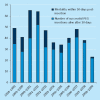Helping the general physician to improve outcomes after PEG insertion: how we changed our practice
- PMID: 21526693
- PMCID: PMC5922733
- DOI: 10.7861/clinmedicine.11-2-132
Helping the general physician to improve outcomes after PEG insertion: how we changed our practice
Abstract
During their careers, most general physicians are involved in the decision-making process for patients that potentially require percutaneous endoscopic gastrostomy (PEG) insertion. However, poor patient selection and less than favourable outcomes are frequently observed in this group. With the aim of identifying and addressing the underlying issues, the PEG service at University Hospital Llandough was radically changed over an eight-year period. The development of a nurse-led pre-assessment service and design of a specific referral form was successful in reducing the number of PEG referrals and consequently the 30-day mortality rate. Furthermore, the educational and training needs of general physicians of all grades regarding the issues surrounding PEG placement were identified and addressed at formal teaching sessions. A combination of these factors has positively impacted on our service, with more appropriate patient selection and a reduced 30-day mortality rate.
Figures
Comment in
-
Improving outcomes following percutaneous endoscopic gastrostomy (PEG)--a seven-day waiting policy is essential.Clin Med (Lond). 2011 Aug;11(4):411. doi: 10.7861/clinmedicine.11-4-411. Clin Med (Lond). 2011. PMID: 21853849 Free PMC article. No abstract available.
References
-
- National Confidential Enquiry into Patient Outcome and Death . Scoping our practice. The 2004 report of the National Confidential Enquiry into Patient Outcome and Death. London: NCEPOD; 2004.
MeSH terms
LinkOut - more resources
Full Text Sources


